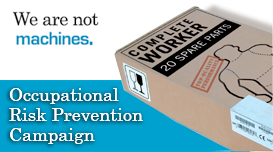Risk Assessment: Construction and Civil Works
Workers Affected by Works Hazards
Rules for acting
- Trench or pit works:
- Unless the inclination of the cut coincides with the natural slope of the ground, it will be necessary to adopt protective measures (shuttering, continued examination of the conditions of the ground, etc.)
- Do not get into trenches with a depth > 1.30 metres without shoring.
- Equipment and materials are generally to be stockpiled at a reasonable distance from the top of slopes depending on the depth of the trench or pit.
- Trenches are to be provided with metal ladders that stick out 1 m above the upper level of the cut, unless there are safe access ramps (with a suitable slope).
- Pit mouths with a dangerous slope are to be protected with solid handrails with an intermediate rail and skirting that impede materials and personnel from falling into the pit.
- One or more workers are to remain outside the trench, pit or gallery to help in the case of an emergency and evacuation.
- In deep pits and trenches, workers are to wear harness-type safety belts, joined to a fall and rescue device.
-
Trenches and excavations:
- When trenches and excavations have a depth equal to or greater than 1.5 metres, they are to be protected by means of railings. When they do not reach this depth, they are to be signposted and cordoned off using signalling tape.
- The inside of footings or trenches are to be accessed by means of portable metal ladders.
- Jumping over floorings or trenches is forbidden.
- Whenever the crossing of floorings or trenches are foreseen, in which the risk of falling onto a different level exists, 60-cm-wide gangways are to be installed provided with a handrail (e.g. vibrating of concrete, unscrewing shuttering, etc.).
Personal protection
- Helmet with chinstrap, goggles and safety footwear.
- Safety harness anchored to a solid, resistant point when working above 1.5 m in height.
- Safety harness when using ladders (above 1.5 m in height) and elevating platforms (always).
- Safety harness when using, erecting and dismantling scaffolding.
- When necessary, the use of horizontal and/or vertical life-lines, fall-arrest drums, double lanyard or any other fall-arrest system that is necessary so as to have anchor points for the harness.
Procedures to apply
- ITS50, ITS51, ITS52, ITS54, ITS55, ITS56.
- ITL12, ITL17, ITL22, ITL23.
- PC0526, PC0713.




